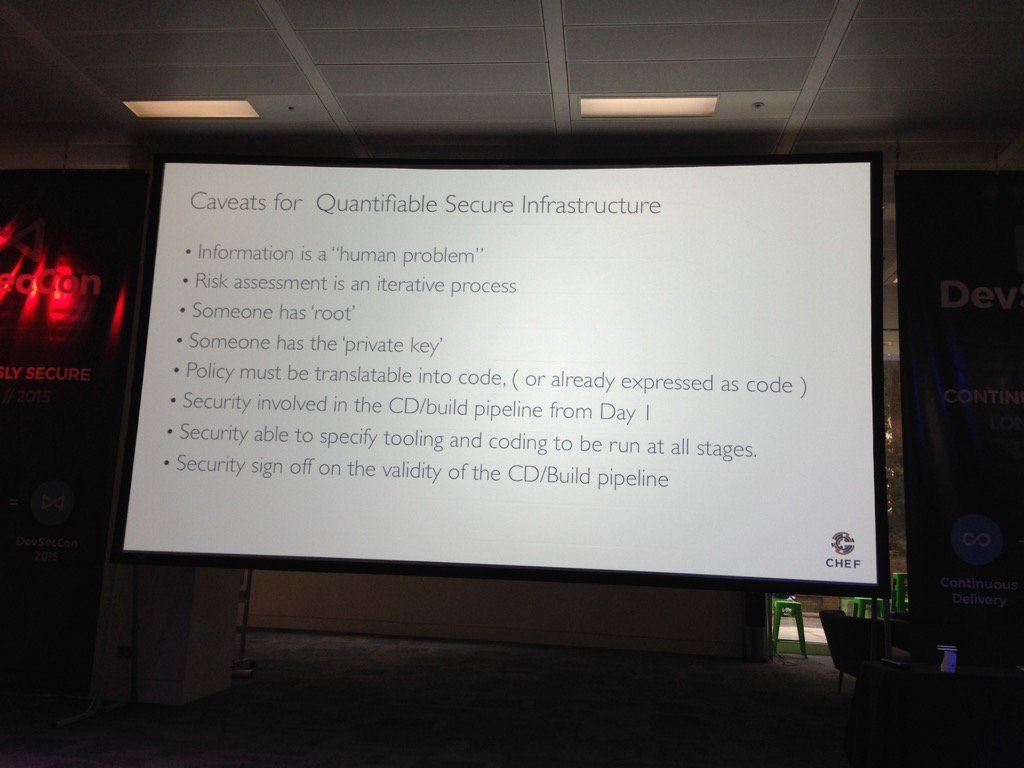DevSecCon 2015
Securing innovation at speed and scale via DevSecOps
- Devops growing faster than security - problem!
- Cloud security is on the rise
- security has to keep up with innovation pace of other engineering features
- Get out of checklist mode; automate security testing
- Problems
- friction for the sake of it
- manual process and meeting culture
- point in time assessments
- thought about outside the value creation process
- Mission - “Target customer value through secure iterative innovation at speed and scale”
- Red and blue team security testing - “find exploits day”
- Security self service is important
- Devsecops
- Security engineering
- experiment, automate, test
- Ops
- hunt, detect, contain
- Compliance operations
- response manage and train
- Security science
- learn, measure, forecast
- Security engineering
- Make it simple
- reduce size of blast radios
- smaller teams, services, failures, APIs
- reduce size of blast radios
- http://www.devsecops.org/
Transforming security from qualitative to quantitative
http://www.slideshare.net/sc0ttruss/chefdevseccon2015
- Quantitative - can be coded, automated etc
- Qualitative - just blah blah blah
- Security as code is the key - it has to be quantitative
- Security happens in tiers
- Trim down the OS - remove what you don’t need
- At check-in to source control
- Running of orchestration jobs
- etc
- Security tests are needed at all steps of the pipeline, not just at the running prod node

- 1 global firewall to 100s of virtual firewalls
Continuous Security Testing
Speaker: http://www.slideshare.net/StephendeVries2 Slides: http://www.slideshare.net/StephendeVries2/continuous-security-testing-devseccon
- Traditionally - security testing happens after the product is built, via external experts
- Security testing is where quality testing was 10 years ago
- Automation tools
- https://github.com/continuumsecurity/bdd-security
- Selenium + OWASP ZAP (HTTP/S Proxy)
- False positives from automation tools are important to remove
- Security test ownership
- Separate security team - nah
- DevOps team owned, with consultancy from security team - maybe
- DevOps + Sec team; one cross-skilled team - yeah
- Manual security tests are still needed; but once a vulnerability is found via a manual test, feed it back to the automated txt suite
- More tools
- Mittn
- ZAP-Junit
- OWASP ZAP Jenkins plugin
- Gauntlet (gauntlt.org)
# Making the Web Secure by Design with OWASP-SKF
## Security Knowledge Framework
- OWASP ASVS checklist - application security verification standard, since 2011
- levels 1-3
- Training
- OWASP security knowledge framework https://www.owasp.org/index.php/OWASP_Security_Knowledge_Framework
# Securing your infrastructure one unit test at a time
- Devops - infrastructure as code
- definitive
- versionable
- reviewable
- shareable
- Reiteration of BDD-Security framework and its usefulness
- Github - search for “gitrob”
- Next time you have a security issue, write a test
- make it go green
- keep it running all the time
# The Tao of security science
- Security science
- F.U.D to facts
- What is your password policy?
- How frequently do you need to patch?
- Min length of password vs algorithm
- Promoting security
- Scoring/grades are powerful motivators
Securing your assets through devops delivery
- Devops and CD principles
- OWASP OpenSAMM (maturity model)
- Security patterns exist - where?
- What about your assets?
- git / your code
- CD server
- Attackers circumvent, not break
- How to secure your assets
- obfuscation - really??!!
- encryption of code in transit
- audit your code footprint
An end to cargo cult security
- Automated vulnerability scans not enough. Manual pen tests are needed
- Can you detect a planned vulnerability scan from your monitoring tools / logs
Whats not to like?
- Make your OS image part of your build
- patching as a separate process disappears
- Only use immutable and young servers
- Don’t let anyone log onto production
- always go via your CD and log monitoring tools etc
- there will be exceptions, which is pl
Chain Reactions
- ~ 90% functionality comes from dependencies
- what about security testing of your dependencies?